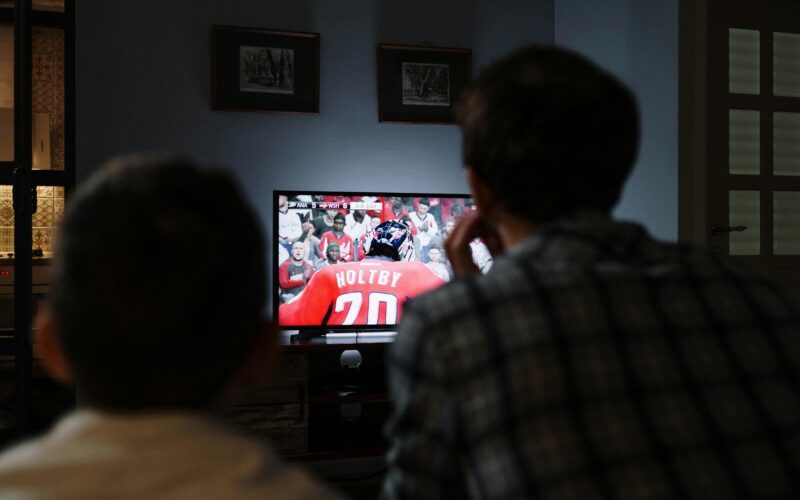Since the Supreme Court’s 2018 decision in Murphy v. National Collegiate Athletic Association (NCAA),1[1]Murphy v. National Collegiate Athletic Association, 138 S. Ct. 1461 (2018). which struck down the federal ban on sports betting, legalized sports gambling has grown exponentially. According to the American Gaming Association, Americans placed an incredible $147.9 billion of sports bets in 2024, a 23.6 percent increase from 2023.2[2]Amy Tennery, U.S. Sports Betting Soars 23.6% Amid Alarming Rise in Addiction, Reuters (Feb. 21, 2025), https://www.reuters.com/sports/us-sports-betting-soars-236-amid-alarming-rise-addiction-2025-02-21/. Sportsbook titans like FanDuel, DraftKings, and BetMGM have become fixtures of televised sporting events, dominating both on-court signage and commercial breaks—making their presence nearly impossible to ignore.
With this gambling boom has come questions and concerns about the practical and ethical repercussions of such advertisements: Is it responsible to promote gambling so prominently during events watched by children and teens? Do these ads exploit psychological vulnerabilities or glamorize risky behavior? And what obligation—if any—do sports leagues, broadcasters, and betting companies have to prioritize public health over profit?
In light of these developments, this article examines whether sports gambling advertisements should face restrictions similar to those once imposed on tobacco advertising. As concerns mount over the potential social and psychological impacts of widespread gambling promotion—particularly on younger and more impressionable audiences—the public interest may be served with stricter advertising standards. Drawing on historical parallels to tobacco regulation, this article explores whether a more cautious, health-focused approach to sports betting ads may be warranted to balance commercial freedoms with societal well-being.
The Ban on Tobacco Advertisements and the First Amendment
The regulation of tobacco advertising offers a compelling historical parallel for today’s debate over sports gambling ads. In the 1960s, cigarette commercials were a staple of American television, often featuring celebrities, cartoon characters, and unsubstantiated health claims.3[3]Tobacco Stops With Me, The History of Tobacco Marketing, https://stopswithme.com/the-history-of-tobacco-marketing/#8203;:contentReference%5Boaicite:0%5D. As mounting evidence linked smoking to serious health risks, public pressure led Congress to pass the Public Health Cigarette Smoking Act of 1969, which banned all cigarette advertising on television and radio effective January 2, 1971.4[4]15 U.S.C. § 1335. The law marked a turning point in public health policy, recognizing that restricting certain types of commercial speech was justified to protect the public—especially young viewers—from harmful influences. This precedent remains central to discussions about regulating advertising of “vice” goods similar societal impacts.
Of course, as with any major government action, the tobacco advertising ban faced significant judicial scrutiny. In 1971, broadcasters challenged the newly enacted ban in Capital Broadcasting Co. v. Mitchell, arguing that it violated their First Amendment rights.5[5]See Capital Broadcasting Co. v. Mitchell, 333 F.Supp 582, 583 (D.C. Cir. 1971). The court upheld the law, emphasizing the government’s compelling interest in protecting public health—particularly for minors—and its authority to regulate commercial speech promoting harmful products.6[6]See Id. at 586. Decades later, in Lorillard Tobacco Co. v. Reilly, the Supreme Court revisited this issue, striking down some state-level advertising restrictions as overly broad but reaffirming that narrowly tailored regulations aimed at protecting youth could be upheld.7[7]See Lorillard Tobacco Co. v. Reily, 533 U.S. 525, 538 (2001).
These rulings hinge on the Central Hudson test, the legal framework for evaluating commercial speech restrictions.8[8]See Central Hudson Gas & Elec. v. Public Svc. Comm’n, 477 U.S. 557 (1980). Under this test, courts ask: (1) whether the speech concerns lawful activity, (2) whether the government’s interest is substantial, (3) whether the regulation directly advances that interest, and (4) whether it is not more extensive than necessary.9[9]See Id. at 566. In the context of sports gambling ads, this test is directly relevant.
How a Sports Gambling Advertising Ban Would Fare Under the Central Hudson Test
Applying the Central Hudson test to a potential ban or restriction on sports gambling advertisements reveals both opportunities and limitations. First, gambling itself is now a lawful activity in most states, and licensed sportsbooks are permitted to advertise their offerings. While the Supreme Court’s decision in Murphy v. NCAA did not directly address advertising, it struck down the federal ban on state-sanctioned sports betting, holding that states are free to legalize the underlying activity.10[10]See Murphy v. National Collegiate Athletic Association, 584 U.S. 453, 480 (2018). As a result, where sports betting is legal, sportsbook advertising qualifies as protected commercial speech under the First Amendment, subject to the Central Hudson framework.
The government likely satisfies the second prong: it has a substantial interest in protecting public health, curbing problem gambling, and shielding minors from potentially harmful influences. The statistics speak for themselves. States that legalized online sports gambling saw personal bankruptcy filings increase 28% over four years following legalization.11[11]Scott Baker, Are Americans Betting Their Future on Sports? Uncover the Surprising Stats, Investopedia (Jan. 10, 2025), https://www.investopedia.com/americans-sports-betting-losing-8768618. Studies have shown gambling disorders can be demonstrated as early as ten-years-old, problem gambling impacts 4-8% of youth, and teens who gamble are more likely to participate in illegal drug use.12[12]Massachusetts Dep’t of Pub. Health, Teens Gambling: It’s a Risk, https://www.mass.gov/info-details/teens-gambling-its-a-risk. Roughly 73% of problem gamblers have an alcohol disorder, 38% have a drug disorder and 60.4% have a nicotine dependence. 13[13]https://pmc.ncbi.nlm.nih.gov/articles/PMC4405260/. In Capital Broadcasting Co. v. Mitchell, the court recognized that where public health is at stake—particularly regarding youth exposure—Congress has the authority to restrict commercial speech promoting harmful products.14[14]See Capital Broadcasting Co., 333 F.Supp at 583. The same rationale applies here: regulating gambling ads, especially those that glamorize betting during family-friendly broadcasts, may be a constitutionally valid means of advancing a critical governmental interest.
The challenge lies in the final two steps. To pass constitutional scrutiny, any restrictions must directly advance that interest and be narrowly tailored—not a blanket ban, but perhaps limits targeting during certain broadcasts or platforms frequented by minors.15[15]See Central Hudson, 447 U.S. at 565. This mirrors the reasoning in Lorillard, where the Court accepted the need to protect youth but struck down overly broad measures.16[16]See Lorillard, 533 U.S at 538. On the other hand, a well-drafted restriction on gambling ads—such as limiting certain promotional language or requiring disclaimers—could survive scrutiny, especially if backed by data showing the impact on at-risk populations.
To satisfy the third prong of the test, the government must demonstrate that restrictions on gambling advertisements would materially advance its substantial interest in protecting public health and curbing addiction.17[17]See Central Hudson, 447 U.S. at 557. The sheer scale of advertising spending underscores the influence of these promotions: DraftKings spent $1.2 billion on marketing in 2024, while FanDuel spent over $335 million.18[18]Statista Research Department, DraftKings Inc. Sales and Marketing Expenses Worldwide from 2020 to 2024, Statista, https://www.statista.com/statistics/1379464/sales-marketing-expenses-draftkings-worldwide/;
Statista Research Department, Top Gambling Industries by Advertising Spend in the U.S. in 2023, Statista, https://www.statista.com/statistics/1538868/leading-gambling-industries-ad-spend-us/. These figures highlight how central aggressive advertising is to user acquisition and engagement. Research has shown that exposure to gambling ads increases the likelihood of problem gambling behaviors, especially among adolescents and young adults.19[19]Grace M. Barnes et al., Gambling and Substance Use: Co-occurrence among Adults in a Recent General Population Study in the United States, 15 Int’l Gambling Stud. 55 (2015), https://pmc.ncbi.nlm.nih.gov/articles/PMC4405260/. If regulators can present empirical data showing that limiting these ads—particularly during high-risk viewing times—reduces gambling-related harm, then the restriction would likely satisfy this prong.
The fourth prong asks whether the regulation is more extensive than necessary.20[20]See Central Hudson, 447 U.S. at 557. Courts generally disfavor blanket bans on truthful, lawful speech. However, narrowly tailored restrictions—such as prohibiting sportsbook ads during live sports broadcasts, banning the use of “risk-free” or misleading promotional language, or preventing partnerships with colleges—can target the most concerning forms of advertising without sweeping up all commercial speech. These targeted approaches mirror those upheld in Lorillard Tobacco Co. v. Reilly, where the Court accepted the need to protect minors but rejected broad, overly restrictive measures.21[21]See Lorillard, 533 U.S. at 528. If regulations focus on mitigating the highest-risk advertising practices while preserving general commercial speech rights, they are more likely to be upheld as constitutionally sound.
Emerging Legislation and Industry Responses to Gambling Ad Concerns
Recent legislative proposals underscore the growing concern over the impact of gambling advertisements. At the federal level, the SAFE Bet Act22[22]Supporting Affordability and Fairness with Every Bet (SAFE Bet) Act, S. 1033, 119th Cong. (2025). —introduced by Senator Richard Blumenthal and Representative Paul Tonko—seeks to prohibit the use of misleading terms like “risk-free” in gambling promotions, ban targeted ads toward minors, and restrict certain forms of inducement marketing. Applying the Central Hudson test, these provisions likely serve a substantial government interest and are narrowly tailored to curb deceptive or harmful advertising practices without imposing a blanket ban. Several states, including New York and New Jersey, have also considered bills to limit gambling ads, particularly those shown during live sports broadcasts or aimed at college students. These efforts suggest a shifting legal and political landscape that may further support the constitutionality of targeted advertising restrictions.
The sports gaming industry has not been entirely passive in the face of mounting scrutiny. Notably, the American Gaming Association (AGA) introduced its Responsible Marketing Code for Sports Wagering, which sets voluntary standards for advertising, including a ban on marketing to minors and the use of misleading terms like “risk-free.” Some companies have also partnered with advocacy groups to promote responsible gambling messages. These private efforts suggest the industry is aware of the regulatory crosshairs it faces and may prefer to shape the rules proactively. However, the effectiveness and enforcement of these voluntary measures remain uneven—raising the question of whether government action is still necessary to ensure uniform public protections.
Conclusion
As legalized sports gambling becomes more embedded in American culture, its advertising footprint has grown just as rapidly, raising serious concerns about public health and consumer protection. Drawing from the regulatory roadmap of tobacco, it’s clear that targeted advertising restrictions, grounded in evidence and tailored to minimize harm, can withstand First Amendment scrutiny. By focusing on protecting youth and curbing deceptive practices, lawmakers can strike a balance between commercial freedom and societal responsibility. As gambling continues to expand, so too must the conversation about how—and where—it should be promoted. The stakes, quite literally, are too high to ignore.
Written by: Theo Gabor
Theo is a 2026 J.D. Candidate at Brooklyn Law School.
[1] Murphy v. National Collegiate Athletic Association, 138 S. Ct. 1461 (2018).
[2] Amy Tennery, U.S. Sports Betting Soars 23.6% Amid Alarming Rise in Addiction, Reuters (Feb. 21, 2025), https://www.reuters.com/sports/us-sports-betting-soars-236-amid-alarming-rise-addiction-2025-02-21/.
[3] Tobacco Stops With Me, The History of Tobacco Marketing, https://stopswithme.com/the-history-of-tobacco-marketing/#8203;:contentReference%5Boaicite:0%5D.
[4] 15 U.S.C. § 1335.
[5] See Capital Broadcasting Co. v. Mitchell, 333 F.Supp 582, 583 (D.C. Cir. 1971).
[6] See Id. at 586.
[7] See Lorillard Tobacco Co. v. Reily, 533 U.S. 525, 538 (2001).
[8] See Central Hudson Gas & Elec. v. Public Svc. Comm’n, 477 U.S. 557 (1980).
[9] See Id. at 566.
[10] See Murphy v. National Collegiate Athletic Association, 584 U.S. 453, 480 (2018).
[11] Scott Baker, Are Americans Betting Their Future on Sports? Uncover the Surprising Stats, Investopedia (Jan. 10, 2025), https://www.investopedia.com/americans-sports-betting-losing-8768618.
[12] Massachusetts Dep’t of Pub. Health, Teens Gambling: It’s a Risk, https://www.mass.gov/info-details/teens-gambling-its-a-risk.
[13] https://pmc.ncbi.nlm.nih.gov/articles/PMC4405260/.
[14] See Capital Broadcasting Co. 333 F.Supp at 583.
[15] See Central Hudson, 447 U.S. at 565.
[16] See Lorillard, 533 U.S at 538.
[17] See Central Hudson, 447 U.S. at 557.
[18] Statista Research Department, DraftKings Inc. Sales and Marketing Expenses Worldwide from 2020 to 2024, Statista, https://www.statista.com/statistics/1379464/sales-marketing-expenses-draftkings-worldwide/; Statista Research Department, Top Gambling Industries by Advertising Spend in the U.S. in 2023, Statista, https://www.statista.com/statistics/1538868/leading-gambling-industries-ad-spend-us/.
[19] Grace M. Barnes et al., Gambling and Substance Use: Co-occurrence among Adults in a Recent General Population Study in the United States, 15 Int’l Gambling Stud. 55 (2015), https://pmc.ncbi.nlm.nih.gov/articles/PMC4405260/.
[20] See Central Hudson, 447 U.S. at 557.
[21] See Lorillard, 533 U.S. at 528.
[22] Supporting Affordability and Fairness with Every Bet (SAFE Bet) Act, S. 1033, 119th Cong. (2025).




